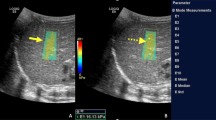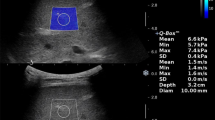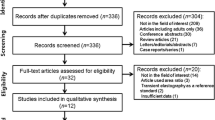Abstract
Background
Traditionally, liver biopsy has been the gold standard for fibrosis staging. However, it is an invasive, expensive and uncomfortable procedure that is associated with the risk of complications. Thus, non-invasive methods such as shear wave elastography (SWE) have been developed as potential alternatives to liver biopsy. The aim of this study is to evaluate the diagnostic performance of SWE in pediatric patients with liver fibrosis, specifically in a group of Algerian children and to determine whether this method can be a reliable alternative to liver biopsy.
Methods
This prospective, descriptive, monocentric study evaluated the non-invasive diagnostic performance of 2D-SWE in assessing liver fibrosis in pediatric patients. The assessment was carried out using various statistical methods, including Spearman's correlation coefficient, Kappa concordance coefficients, regression analysis, as well as the calculation of area under the receiver operating characteristic (AUROC) values and corresponding cut-off points based on the receiver operating characteristic (ROC) curve.
Results
Our study found that 2D-SWE is strongly correlated with liver biopsy in estimating liver fibrosis in children, with a correlation coefficient greater than 0.8. Furthermore, the Kappa correlation coefficients exceeded 0.8, indicating a strong agreement between 2D-SWE and liver biopsy results. The AUROC value was not less than 0.9 for significant fibrosis and above (≥ F2), indicating that it has satisfactory diagnostic performance in detecting liver fibrosis in children.
Conclusion
2D-SWE shows promise as a non-invasive method for evaluating liver fibrosis in children, offering a potential alternative to liver biopsy. Larger studies are needed to substantiate the findings of this study and to confirm the accuracy and reliability of 2D-SWE for assessing liver fibrosis in children.
Graphical abstract

Similar content being viewed by others
Data availability
The data that support the findings of this study are available upon request from the corresponding author, Samia BICHA (samia.bicha@univ-constantine3.dz). However, the data cannot be shared publicly due to privacy or ethical restrictions. The dataset includes the results of the Shear Wave Elastography (SWE) tests, liver biopsy and the statistical analyses performed to evaluate the diagnostic performance of both non-invasive tests in pediatric patients with liver fibrosis. The data will be made available to researchers who meet the criteria for access to confidential data, after obtaining the necessary approvals from the relevant authorities.
References
Dhole SD, Kher AS, Ghildiyal RG, Tambse MP. Chronic liver diseases in children: Clinical profile and histology. J Clin Diagn Res. 2015;9:SC04–7.
Yang CH, Perumpail BJ, Yoo ER, Ahmed A, Kerner JA Jr. Nutritional needs and support for children with chronic liver disease. Nutrients. 2017;9:1127.
Ruzman L, Mikolasevic I, BarabaDekanic K, Milic S, Palcevski G. Advances in diagnosis of chronic liver diseases in pediatric patients. World J Pediatr. 2018;14:541–7.
Widodo AD, Soelaeman EJ, Dwinanda N, Narendraswari PP, Purnomo B. Chronic liver disease is a risk factor for malnutrition and growth retardation in children. Asia Pac J Clin Nutr. 2017;26:s57-60.
Young S, Kwarta E, Azzam R, Sentongo T. Nutrition assessment and support in children with end-stage liver disease. Nutr Clin Pract. 2013;28:317–29.
Bedossa P. Sampling variability of liver fibrosis in chronic hepatitis C. Hepatology. 2003;38:1449–57.
Xiao G, Zhu S, Xiao X, Yan L, Yang J, Wu G. Comparison of laboratory tests, ultrasound, or magnetic resonance elastography to detect fibrosis in patients with nonalcoholic fatty liver disease: A meta-analysis. Hepatology. 2017;66:1486–501.
Van Thiel DH, Gavaler JS, Wright H, Tzakis A. Liver biopsy. Its safety and complications as seen at a liver transplant center. Transplantation. 1993;55:1087–90.
Hwang J-Y, Yoon HM, Kim JR, et al. Diagnostic performance of transient elastography for liver fibrosis in children: A systematic review and meta-analysis. Am J Roentgenol. 2018;211:W257–66.
Berzigotti A, Abraldes JG, Tandon P, et al. Ultrasonographic evaluation of liver surface and transient elastography in clinically doubtful cirrhosis. J Hepatol. 2010;52:846–53.
Sandrin L, Fourquet B, Hasquenoph J-M, et al. Transient elastography: a new noninvasive method for assessment of hepatic fibrosis. Ultrasound Med Biol. 2003;29:1705–13.
Arena U, Vizzutti F, Abraldes JG, et al. Reliability of transient elastography for the diagnosis of advanced fibrosis in chronic hepatitis C. Gut. 2008;57:1288–93.
Lupşor-Platon M, Badea R, Gersak M, et al. Noninvasive assessment of liver diseases using 2D shear wave elastography. J Gastrointestin Liver Dis. 2016;25:525–32.
Jain V, Poddar U, Negi TS, et al. Utility and accuracy of transient elastography in determining liver fibrosis: a case-control study. Eur J Pediatr. 2020;179:671–7.
Fitzpatrick E, Quaglia A, Vimalesvaran S, Basso MS, Dhawan A. Transient elastography is a useful noninvasive tool for the evaluation of fibrosis in paediatric chronic liver disease. J Pediatr Gastroenterol Nutr. 2013;56:72–6.
Behairy BE-S, Sira MM, Zalata KR, Salama E-SE, Abd-Allah MA. Transient elastography compared to liver biopsy and morphometry for predicting fibrosis in pediatric chronic liver disease: Does etiology matter? World J Gastroenterol. 2016;22:4238–49.
Shen Q-L, Chen Y-J, Wang Z-M, et al. Assessment of liver fibrosis by Fibroscan as compared to liver biopsy in biliary atresia. World J Gastroenterol. 2015;21:6931–6.
Nobili V, Vizzutti F, Arena U, et al. Accuracy and reproducibility of transient elastography for the diagnosis of fibrosis in pediatric nonalcoholic steatohepatitis. Hepatology. 2008;48:442–8.
Tran LC, Ley D, Bourdon G, et al. Noninvasive pediatric liver fibrosis measurement: Two-dimensional shear wave elastography compared with transient elastography. Front Pediatr. 2022;10:849815.
Ding C, Wang Z, Peng C, Pang W, Tan SS, Chen Y. Diagnosis of liver cirrhosis with two-dimensional shear wave elastography in biliary atresia before Kasai portoenterostomy. Pediatr Surg Int. 2022;38:209–15.
Lin Y, Ding H, Zhuang Y, Zhang Y, Zhu YL, Wang WP. Expanded clinical verification of effectiveness of two-dimensional-shear wave elastography in the noninvasive evaluation of hepatic fibrosis. Zhonghua Yi Xue Za Zhi. 2018;98:1148–51.
Kim DW, Suh CH, Kim KW, Pyo J, Park C, Jung SC. Technical performance of two-dimensional shear wave elastography for measuring liver stiffness: a systematic review and meta-analysis. Korean J Radiol. 2019;20:880–93.
Varbobitis IC, Siakavellas SI, Koutsounas IS, et al. Reliability and applicability of two-dimensional shear-wave elastography for the evaluation of liver stiffness. Eur J Gastroenterol Hepatol. 2016;28:1204–9.
Nakamura Y, Aikata H, Fukuhara T, et al. Liver fibrosis assessment by FibroScan compared with pathological findings of liver resection specimen in hepatitis C infection. Hepatol Res. 2017;47:767–72.
de Lédinghen V, Le Bail B, Rebouissoux L, et al. Liver stiffness measurement in children using fibroscan: Feasibility study and comparison with fibrotest, aspartate transaminase to platelets ratio index, and liver biopsy. J Pediatr Gastroenterol Nutr. 2007;45:443–50.
Breton E, Bridoux-Henno L, Guyader D, et al. Value of transient elastography in noninvasive assessment in children’s hepatic fibrosis. Arch Pediatr. 2009;16:1005–10.
Fraquelli M, Rigamonti C, Casazza G, et al. Reproducibility of transient elastography in the evaluation of liver fibrosis in patients with chronic liver disease. Gut. 2007;56:968–73.
Farmakis SG, Buchanan PM, Guzman MA, Hardy AK, Jain AK, Teckman JH. Shear wave elastography correlates with liver fibrosis scores in pediatric patients with liver disease. Pediatr Radiol. 2019;49:1742–53.
Gao Y, Zhu L, Xiao H, et al. Clinical study of the value of shear wave elastography in evaluating the degree of liver fibrosis in children. Abdom Radiol. 2023;48:1298–305.
Microsoft Corporation (2013) Microsoft Excel 2013 [Computer software].
IBM Corp. Released 2012. IBM SPSS Statistics for Windows, Version 21.0. Armonk, NY: IBM Corp.
Goksuluk D, Korkmaz G, Karaagaoglu A Ergun. easyROC: An Interactive Web-tool for ROC Curve Analysis Using R Language Environment [Internet]. n.d. [cited 2023 August 10]. Available from: http://biosoft.erciyes.edu.tr/app/easyROC/.
Lee S, Choi YH, Cho YJ, et al. The usefulness of noninvasive liver stiffness assessment using shear-wave elastography for predicting liver fibrosis in children. BMC Med Imaging. 2021;21:68.
Gao Y, Zhu L, Xiao H, et al. Clinical study of the value of shear wave elastography in evaluating the degree of liver fibrosis in children. Abdom Radiol (NY). 2023;48:1298–305.
Tutar O, Beşer ÖF, Adaletli I, et al. Shear wave elastography in the evaluation of liver fibrosis in children. J Pediatr Gastroenterol Nutr. 2014;58:750–5.
Galina P, Alexopoulou E, Mentessidou A, et al. Diagnostic accuracy of two-dimensional shear wave elastography in detecting hepatic fibrosis in children with autoimmune hepatitis, biliary atresia and other chronic liver diseases. Pediatr Radiol. 2021;51:1358–68.
Garcovich M, Veraldi S, Di Stasio E, et al. Liver stiffness in pediatric patients with fatty liver disease: Diagnostic accuracy and reproducibility of shear-wave elastography. Radiology. 2017;283:820–7.
Lee SM, Lee JM, Kang H-J, et al. Liver fibrosis staging with a new 2D-shear wave elastography using comb-push technique: Applicability, reproducibility, and diagnostic performance. PLoS One. 2017;12:e0177264.
Samir AE, Dhyani M, Vij A, et al. Shear-wave elastography for the estimation of liver fibrosis in chronic liver disease: determining accuracy and ideal site for measurement. Radiology. 2015;274:888–96.
Ferraioli G, Tinelli C, Dal Bello B, et al. Accuracy of real-time shear wave elastography for assessing liver fibrosis in chronic hepatitis C: A pilot study. Hepatology. 2012;56:2125–33.
Castéra L, Vergniol J, Foucher J, et al. Prospective comparison of transient elastography, Fibrotest, APRI, and liver biopsy for the assessment of fibrosis in chronic hepatitis C. Gastroenterology. 2005;128:343–50.
Wong VW-S, Vergniol J, Wong GL-H, et al. Diagnosis of fibrosis and cirrhosis using liver stiffness measurement in nonalcoholic fatty liver disease. Hepatology. 2010;51:54–62.
Huwart L, Sempoux C, Vicaut E, et al. Magnetic resonance elastography for the noninvasive staging of liver fibrosis. Gastroenterology. 2008;135:32–40.
Acknowledgements
The authors express their sincere appreciation to the following individuals and services for their invaluable contributions to this study:
• Regional Military University Hospital of Constantine.
• Gastrology and Hepatology service of University Hospital Constantine.
• Anatomopathological Service of University Hospital Constantine.
• Medical imaging service of University Hospital Constantine
• Pediatric surgery department of Mansourah Hospital.- Abdelghani May, Ahmed Hamada, Amina Bensebti, Mustapha Boumendjel, Mounir Kout. The authors are deeply grateful for the unwavering dedication and support provided by these individuals and services, without which this study would not have been possible.
Author information
Authors and Affiliations
Contributions
S.B. was responsible for the study conception and design, material preparation, data collection and analysis, writing of the original draft and review and editing of the manuscript. H.B. provided conceptualization and supervision for the study. A.L. contributed to data analysis and review and editing of the manuscript. All authors read and approved the final manuscript.
Corresponding author
Ethics declarations
This study was conducted in accordance with the principles of the Declaration of Helsinki and was approved by the institutional review board of the University of Constantine 3- Salah Boubnider. Informed consent was obtained from the parents or legal guardians of all participants prior to enrollment in the study. All patient data was anonymized and kept confidential throughout the study. No conflict of interest was reported by the authors.
Conflict of interest
SB, HB and AL declare no competing interests.
Financial interests
The authors declare they have no financial interests.
Ethics approval
Approval was obtained from the ethics committee of the Constantine University Hospital. The procedures used in this study adhere to the tenets of the Declaration of Helsinki.
Consent to participate
Written informed consent was obtained from parents.
Disclaimer
The authors are solely responsible for the data and the contents of the paper. In no way, the Honorary Editor-in-Chief, Editorial Board Members, the Indian Society of Gastroenterology or the printer/publishers are responsible for the results/findings and content of this article.
Additional information
Publisher's Note
Springer Nature remains neutral with regard to jurisdictional claims in published maps and institutional affiliations.
Supplementary Information
Below is the link to the electronic supplementary material.
Rights and permissions
Springer Nature or its licensor (e.g. a society or other partner) holds exclusive rights to this article under a publishing agreement with the author(s) or other rightsholder(s); author self-archiving of the accepted manuscript version of this article is solely governed by the terms of such publishing agreement and applicable law.
About this article
Cite this article
Bicha, S., Boumaraf, H. & Lakehal, A. Shear wave elastography as a non-invasive tool for staging liver fibrosis in children: A study in Algerian pediatric patients. Indian J Gastroenterol (2023). https://doi.org/10.1007/s12664-023-01464-3
Received:
Accepted:
Published:
DOI: https://doi.org/10.1007/s12664-023-01464-3




